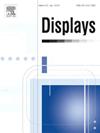Point cloud upsampling via implicit shape priors discovery and refinement
IF 3.7
2区 工程技术
Q1 COMPUTER SCIENCE, HARDWARE & ARCHITECTURE
引用次数: 0
Abstract
The point clouds obtained by scanning sensors are often sparse and non-uniform, therefore, point cloud upsampling is of vital importance. This paper considers geometric priors as a rich source to guide point cloud generation for the better qualities. However, it is less flexible to explicitly exploit geometric priors of object surface, such as local geometric smoothness and fairness. In light of this, this paper proposes a novel two-stage method via discovering and exploiting implicit shape priors, which can consist of coarse point cloud upsampling and fine details refining. Specifically, at the first stage, we explore to discover geometric priors in an implicit manner via Dual Transformer, which simultaneously addressing local and global information during feature encoding, while a Neighborhood Refinement module is proposed to handle with geometric irregularities and noises via exploiting feature similarity of neighboring points. Extensive experiments on synthetic and real datasets validate our motivation, demonstrating that our method achieves competitive performance compared to SOTA methods, and better results for noisy point clouds. The source code of this work is available at https://github.com/Vencoders/PU-DT.
通过隐式形状先验发现和细化点云上采样
扫描传感器获得的点云往往是稀疏且不均匀的,因此对点云进行上采样至关重要。本文将几何先验作为指导点云生成的丰富资源,以获得更好的质量。然而,明确地利用物体表面的几何先验,如局部几何平滑性和公平性,灵活性较差。鉴于此,本文提出了一种新的通过发现和利用隐式形状先验的两阶段方法,该方法包括粗点云上采样和精细细节细化。具体而言,在第一阶段,我们探索了通过Dual Transformer以隐式方式发现几何先验,该方法在特征编码过程中同时处理局部和全局信息,同时提出了一个邻域优化模块,通过利用邻近点的特征相似性来处理几何不规则性和噪声。在合成数据集和真实数据集上的大量实验验证了我们的动机,表明我们的方法与SOTA方法相比具有竞争力的性能,并且在噪声点云上取得了更好的结果。该工作的源代码可从https://github.com/Vencoders/PU-DT获得。
本文章由计算机程序翻译,如有差异,请以英文原文为准。
求助全文
约1分钟内获得全文
求助全文
来源期刊

Displays
工程技术-工程:电子与电气
CiteScore
4.60
自引率
25.60%
发文量
138
审稿时长
92 days
期刊介绍:
Displays is the international journal covering the research and development of display technology, its effective presentation and perception of information, and applications and systems including display-human interface.
Technical papers on practical developments in Displays technology provide an effective channel to promote greater understanding and cross-fertilization across the diverse disciplines of the Displays community. Original research papers solving ergonomics issues at the display-human interface advance effective presentation of information. Tutorial papers covering fundamentals intended for display technologies and human factor engineers new to the field will also occasionally featured.
 求助内容:
求助内容: 应助结果提醒方式:
应助结果提醒方式:


